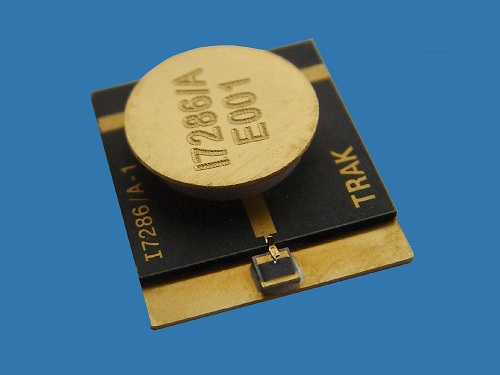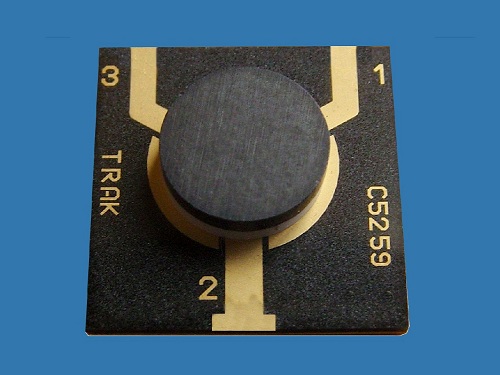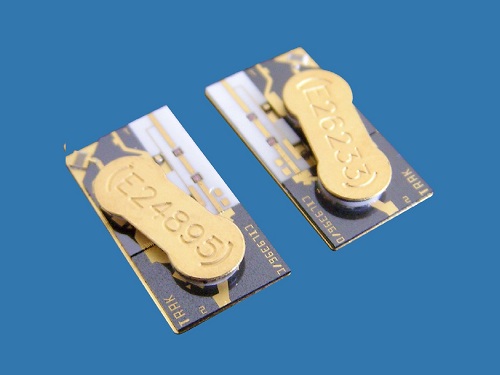Microstrip isolators and circulators are broadband structures offer a unique blend of broad band operation, low mass & low profile which together make them ideal for use in hybrids for space and terrestrial AESA applications.

The first modern microstrip isolators and circulators were developed by TRAK in the late 1990s. Shortly after that devices were supplied for experimental AESA applications for fighter aircraft and for civilian earth observing satellites.
The first microstrip devices produced by what is today TRAK were designed and fabricated in the 1970’s and used in what was a cutting edge radar family today known as SeaSpray and supported to this day by SELEX ES based in Edinburgh. The products then and now bear a passing resemblance but the performance achieved using today’s materials and processes are incomparably better with operating bandwidths of to 40% and power handling in C & X band of 50W CW.
Since the first space parts were supplied in 2001 for the Cosmo SKYMED program TRAK has supplied over 73,000 junctions for use on 24 payloads involved in earth observation for scientific and security applications. TRAK has supplied C, X, Ku, and K band stripline to 12 distinct customers.
TRAK has a unique heritage having supplied over 400k microstrip isolators and circulators for space and terrestrial based radar and industrial telecommunications applications. TRAK’s capability extends from 2.7 GHz to 31 GHz with unconditionally linear products that include single junction isolators and circulators & dual junction isolators and duplexers.
Key advantages
- Tuneless broadband structures
- Lowest mass of any ferrite isolator or circulator
- TRAK devices are made using processes and from materials with outstanding heritage
- Space qualified and suitable for hybrid applications
- Exceptional RF performance
- ITAR free


| Operating Band [GHz] | Insertion Loss [dB max] | Return Loss [dB min] | Isolation Loss [dB min] | Application | Notes |
| 3.4 to 4.2 | 0.30 | 21.0 | 21.0 | Space & Defence | Circulator |
| 5.0 to 6.0 | 0.30 | 21.0 | 21.0 | Defence | Isolator |
| 5.2 to 5.9 | 0.30 | 21.0 | 21.0 | Space & Defence | Circulator |
| 5.7 to 7.1 | 0.30 | 21.0 | 21.0 | Space | Circulator & Isolator |
| 5.8 to 6.5 | 0.30 | 21.0 | 21.0 | Space & Defence | Circulator & Isolator |
| 7.8 to 8.5 | 0.30 | 21.0 | 21.0 | Space & Defence | Circulator & Isolator |
| 8.0 to 12.0 | 0.30 | 15.0 | 15.0 | Space & Defence | Circulator & Isolator |
| 8.5 to 9.6 | 0.30 | 21.0 | 21.0 | Defence | Circulator & Isolator |
| 8.9 to 10.7 | 0.30 | 21.0 | 21.0 | Space & Defence | Circulator |
| 9.0 to 10.0 | 0.30 | 21.0 | 21.0 | Space & Defence | Circulator & Isolator |
| 9.5 to 11.5 | 0.30 | 21.0 | 21.0 | Space & Defence | Circulator & Isolator |
| 10.0 to 12.0 | 0.30 | 15.0 | 15.0 | Space & Defence | Circulator |
| 10.0 to 12.0 | 0.40 | 14.0 | 14.0 | Space & Defence | Circulator & Isolator |
| 10.7 to 12.8 | 0.40 | 20.0 | 20.0 | Space & Defence | Circulator & Isolator |
| 12.7 to 14.5 | 0.40 | 20.0 | 20.0 | Space | Isolator |
| 15.0 to 17.0 | 0.50 | 20.0 | 20.0 | Defence | Circulator |
| 24.0 to 27.0 | 0.50 | 19.0 | 19.0 | Space | Isolator |



